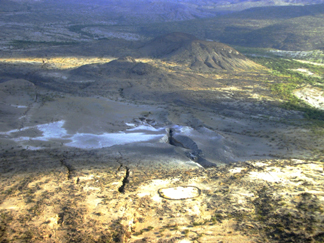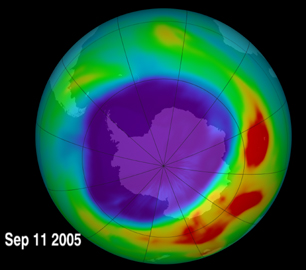Geotimes

Untitled Document

Geophenomena
A far-off new ocean
Longer to patch the ozone hole
A far-off
new ocean
 A new
ocean basin opened up in an African desert last fall, or at least, made its
first cracks. The ruptures, researchers say, could mark the beginning of an
inland sea in Ethiopia’s East African rift zone.
A new
ocean basin opened up in an African desert last fall, or at least, made its
first cracks. The ruptures, researchers say, could mark the beginning of an
inland sea in Ethiopia’s East African rift zone.
This 6-meter-wide fissure in Ethiopia’s
East African rift zone spouted ash after earthquakes shook the region, in what
may be the first visible events leading to ocean spreading in the rift. Image
courtesy of Cynthia Ebinger.
In September, a large earthquake followed by a series of tremors shook the region,
and about a week later, a segment of the rift spewed ash in a volcanic eruption
and tore several cracks amounting to an opening of more than 6 meters at the
surface, according to Cynthia Ebinger, a geologist at Royal Holloway University
of London. “It appears that we’ve seen the birth of an ocean basin,”
she told the BBC Dec. 8.
The new opening is part of the Afar triple junction (also sometimes called the
Gulf of Aden triple junction), where the Arabian and African plates come together
at a point where Africa is also splitting. The newly active portion of the basin,
about 20 kilometers wide and 60 kilometers long, is fractured by a series of
1.8-million-year-old faults, with the new fissures splitting it further. Researchers
hailing from a variety of institutions, including Royal Holloway University
of London, University of Oxford and Addis Ababa University in Ethiopia, have
tracked strain and movement in the region with seismic arrays as well as by
satellite. Taken together with eyewitness accounts, the data, presented by the
researchers at the American Geophysical Union annual meeting in San Francisco
in December, suggest that the system is transitioning between continental rifting
to oceanic spreading, accompanied by changes in the rocks beneath.
Hot magma from the mantle welling up under the southern part of the zone may
be facilitating the rifting, members of the research group suggested, in a region
where tectonic forces are too small to explain the rifting occurring now. Although
this may be the first time human eyes have observed such speedy and perceptible
rifting, it will take millions of years for a true ocean to develop here: Researchers
predicted that the rift will continue to pull apart very slowly, at around 6
millimeters per year.
Naomi Lubick
Back to top
 Longer
to patch the ozone hole
Longer
to patch the ozone hole
Scientists predicted in 2002 that the atmosphere’s ozone “holes”
would recover to 1980 levels by 2050. But new research shows the ozone layer will
take 15 years longer to heal than previously thought.
Not quite a “hole,” ozone depletion
in the Antarctic reaches its maximum from August to October every year. Last year,
the peak occurred Sept. 11, shown here in blue, slightly larger than the maximum
depletion in 2004 — but almost 2 million square kilometers smaller than the
largest ever measured in 1998, which averaged about 26 million square kilometers.
Scientists announced revised recovery dates for the ozone holes at both poles
in December. Image courtesy of NASA/GSFC.
After the discovery of an ozone hole in the Antarctic in 1985, researchers determined
that chlorofluorocarbons (CFCs) and halon gases had destroyed ozone in a layer
that protects Earth from ultraviolet rays, over both the Arctic and Antarctic.
International efforts taken in 1996 to stop the manufacture and use of CFCs had
dramatically reduced the amount of the substances, which travel into the lower
atmosphere. There, strong ultraviolet light breaks up the molecules, freeing chlorine,
which can destroy ozone.
Despite the ban on CFCs, new research shows that emissions of the molecules in
2003 from the United States and Canada still ranged from 10 to 45 percent of the
global total, according to Dale Hurst of the National Oceanic and Atmospheric
Administration (NOAA) Global Monitoring Division in Boulder, Colo., and his co-workers.
Hurst hypothesizes that in addition to continued manufacture and use in developing
countries, remaining pools of CFCs in old appliances and even car air conditioners
are enough to extend the damaging effects of the chemical by a decade and a half
more than modelers previously thought. More CFCs may also come from sources squirreled
away after manufacturing officially ended, he said in a Dec. 6 presentation at
the American Geophysical Union (AGU) meeting in San Francisco.
The ozone hole in the Antarctic reached its maximum last year on Sept. 11, when
temperature conditions and chemical concentrations hit their prime during the
Antarctic spring, according to Michelle Santee of NASA’s Jet Propulsion Laboratory
in Pasadena, Calif. Using NASA’s Aura satellite, which has been tracking
global ozone levels and other ozone-depleting chemicals since its launch in 2004,
Santee and co-workers have determined that seasonal changes in ozone levels vary
at the north and south poles.
Monitoring so far, she said at the AGU meeting, shows that the Arctic gets warm
enough so that chlorine-containing molecules have less of a destructive effect
than in Antarctica, where it is cold enough to maintain the chemical reactions
that destroy ozone year-round. But wind patterns in the Arctic also disperse chemicals
and ozone, enough so that the status of ozone at the northern pole remains unclear,
Santee said.
The condition of the Arctic, where the ozone hole may mend by 2030 or 2040, still
seems likely to improve more rapidly than at the southern pole, according to John
Austin of NOAA’s Geophysical Fluid Dynamics Laboratory at Princeton University
in New Jersey. The Antarctic hole most likely will not recover until 2065, but
even that prediction remains subject to the variability in chemistry and the two
polar environments.
Naomi Lubick
Back to top
Untitled Document


 A new
ocean basin opened up in an African desert last fall, or at least, made its
first cracks. The ruptures, researchers say, could mark the beginning of an
inland sea in Ethiopia’s East African rift zone.
A new
ocean basin opened up in an African desert last fall, or at least, made its
first cracks. The ruptures, researchers say, could mark the beginning of an
inland sea in Ethiopia’s East African rift zone. Longer
to patch the ozone hole
Longer
to patch the ozone hole